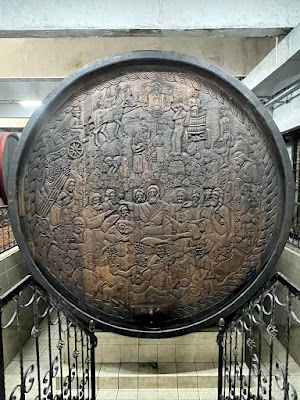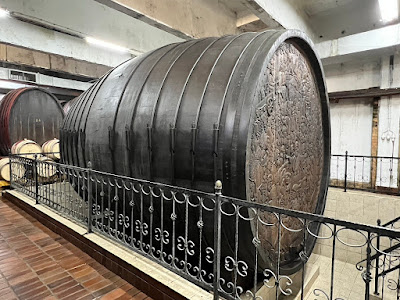In 1984, their new winery was opened and it has an annual capacity of 6.5M liters (about 677K cases) however they only produce about 3.5M liters, and have no plans to expand. Their wine production is about 70% white and 30% red wine, and most is sold within Croatia, although they have recently started exporting a tiny amount to Scotland.
We began our tour of Erdut in the oldest part of the cellar, from 1730, which was constructed by Baron Johann Baprista Maximilian Zuan. Over the doorway is a sign that states in Croatian: Cistu savest cisto vino nezelmo si bratjo ino jer u sreci iu bedi ovo ovoje mnoco vredi. It roughly translates as: "We don't want a clean conscience, clean wine, brother, because in happiness and in misery, this is worth a lot."
This cellar is naturally 13 degrees Celsius with 60% humidity, which is perfect for wine storage. Currently, they only store Sparkling wines here.
In 1778, Ivan Kapistran I. Adamovich de Csepin bought the property and his daughter, Fanny Adamovich Čepinska, took up residence on the property. She married Count Erwin Cech, who was relatively poor at the time, and it's said they often fought together. The Count had five large wine barrels built into the walls of the old cellar, although one of those barrels hid a great secret.
The Count was an avid card player, and it seems he didn't want his wife to know how often he played. So, one of those large barrels actually concealed a small room where the Count could hide, and play cards with a few friends. One time, he sent his wife a letter, claiming he was on a boat trip to Budapest, when he actually was playing cards in his secret wine barrel.
Upon the death of his wife, the Count then built an octagonal tower to the castle, which could accommodate four card players. He also remarried, to the Hungarian Countess Juliška, who had no problems with his card playing, so he didn't need to hide out in his barrel anymore.
Wandering around the property, there is both a sense of history as well as a taste of beauty and serenity.
This is it! A huge barrel with a capacity of 75,000 liters, basically 100,000 wine bottles. The barrel was constructed in 1989 by DIK Đurđenovac, as part of a competition. The barrel was made from 109 Slavonian oak trees, basically a small forest. It's also held together by 3.5 tons of iron, the inside of the barrel is lined with wax, and the entire barrel, while empty, weighs about 20 tons, and 90-95 tons when it's full.
The first photo fails to properly represent the enormity of the barrel, but this picture helps to provide some necessary context. With Todd Godbout (of Wine Compass) and I standing in front, dwarfed by this oak giant, you get a much better context for the great size of the barrel.
Entry to the barrel is gained from the rear, and the barrel is filled each year with Graševina. It takes approximately 12+ hours to fill the entire barrel. As their website states: "It is always full of graševina, because graševina is the symbol of the whole wine-making area, as well as the company Erdutski vinogradi d.o.o."
The fascinating and intricate carvings on the front of the barrel were added about seven years after the barrel was completed. These carvings were created by Mato Tijardović and Fodor (I'm unsure of his first name), who are naive sculptors. Naive art generally refers to artists who lack professional training, and whose work is often straightforward and simple. In Croatia, there is even a Museum of Naive Art.
There is so much going on in this elaborate and beautiful carving such as a portrait of St. Martin, whose saint day is November 11. There's also a depiction of the Last Supper where Jesus is holding a chalice of wine. All of the images and scenes on the barrel are wine-related, and it added to the aw-inspiring beauty of the cyclopean barrel.
Standing near the huge barrel, we also tasted several wines, none of which were on the market yet. Of course we started with the 2020 Graševina, which had spent time in the enormous barrel. It's considered a "quality wine," not a "premium" one, and with a 13% ABV, it was crisp, fresh, dry and fruity, easy-drinking and pleasant. A nice every-day drinking wine, just fine on its own.
Standing near the huge barrel, we also tasted several wines, none of which were on the market yet. Of course we started with the 2020 Graševina, which had spent time in the enormous barrel. It's considered a "quality wine," not a "premium" one, and with a 13% ABV, it was crisp, fresh, dry and fruity, easy-drinking and pleasant. A nice every-day drinking wine, just fine on its own.
We also tasted the premium version of the 2020 Grasevina, with a 14% ABV, which had a similar profile except more complexity, a bit more richness, and a hint of spruce.
The 2021 Pinot Sivi (Gris), with a 14.7% ABV, was fruity and crisp, with a touch of apparent sweetness, and a nice character. The 2021 Rosé, with a 11.5% ABV, was produced from Cabernet Sauvignon. With a pleasant fruity aroma, it was dry and crisp, with bright strawberry flavors.
Some of the other wines they produce include the Traminer Aromatico, an ice wine, which is also their most awarded wine. Their first Sparkling wine is the Meander, a blend of Chardonnay and Pinot Noir. "Meander" refers to a location near the Danube, and that location is presented on the label.
The 2021 Pinot Sivi (Gris), with a 14.7% ABV, was fruity and crisp, with a touch of apparent sweetness, and a nice character. The 2021 Rosé, with a 11.5% ABV, was produced from Cabernet Sauvignon. With a pleasant fruity aroma, it was dry and crisp, with bright strawberry flavors.
Some of the other wines they produce include the Traminer Aromatico, an ice wine, which is also their most awarded wine. Their first Sparkling wine is the Meander, a blend of Chardonnay and Pinot Noir. "Meander" refers to a location near the Danube, and that location is presented on the label.





















No comments:
Post a Comment